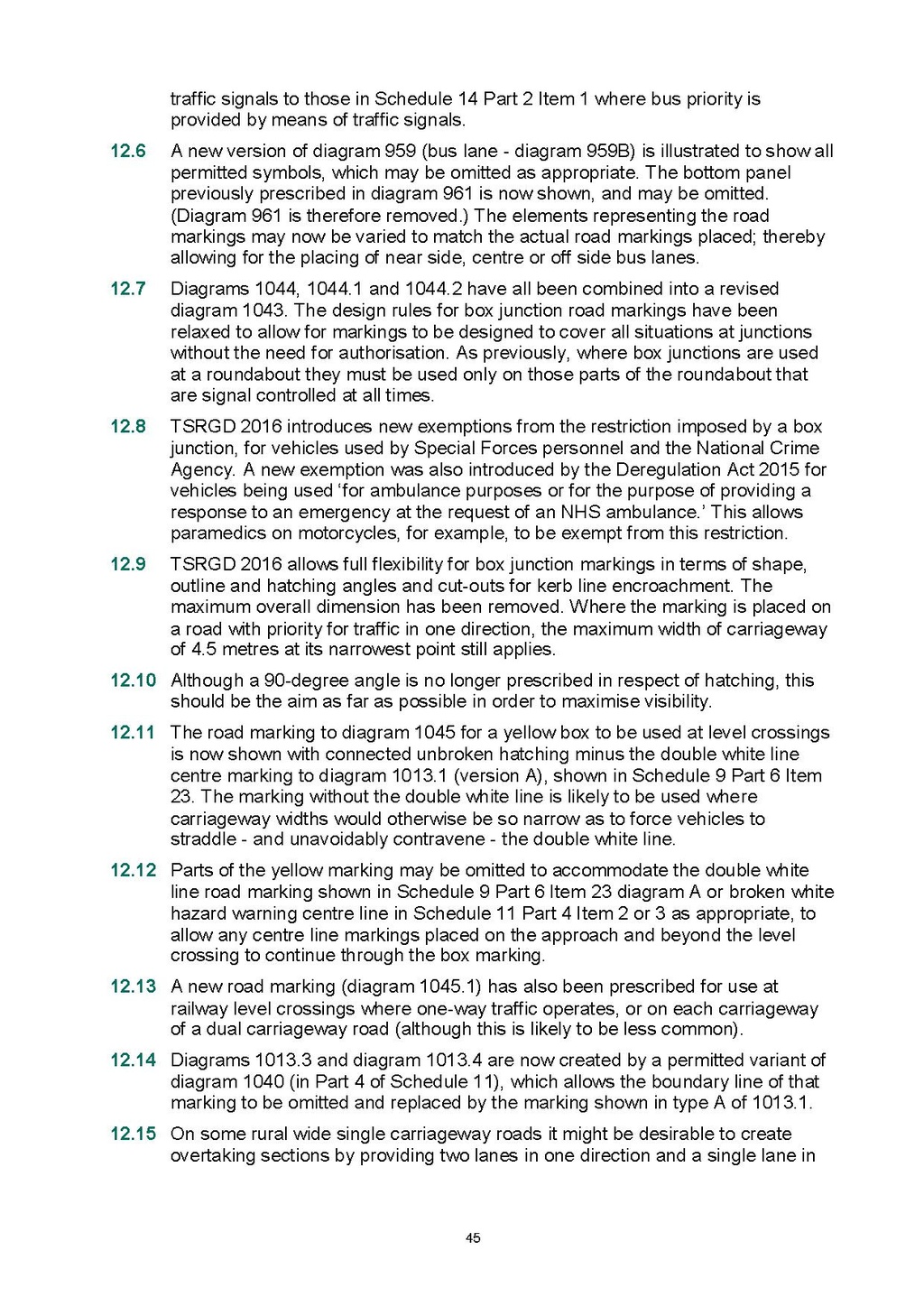This page has been validated.
traffic signals to those in Schedule 14 Part 2 Item 1 where bus priority is provided by means of traffic signals.
12.6
A new version of diagram 959 (bus lane - diagram 959B) is illustrated to show all permitted symbols, which may be omitted as appropriate. The bottom panel previously prescribed in diagram 961 is now shown, and may be omitted. (Diagram 961 is therefore removed.) The elements representing the road markings may now be varied to match the actual road markings placed; thereby allowing for the placing of near side, centre or off side bus lanes.
12.7
Diagrams 1044, 1044.1 and 1044.2 have all been combined into a revised diagram 1043. The design rules for box junction road markings have been relaxed to allow for markings to be designed to cover all situations at junctions without the need for authorisation. As previously, where box junctions are used at a roundabout they must be used only on those parts of the roundabout that are signal controlled at all times.
12.8
TSRGD 2016 introduces new exemptions from the restriction imposed by a box junction, for vehicles used by Special Forces personnel and the National Crime Agency. A new exemption was also introduced by the Deregulation Act 2015 for vehicles being used 'for ambulance purposes or for the purpose of providing a response to an emergency at the request of an NHS ambulance.' This allows paramedics on motorcycles, for example, to be exempt from this restriction.
12.9
TSRGD 2016 allows full flexibility for box junction markings in terms of shape, outline and hatching angles and cut-outs for kerb line encroachment. The maximum overall dimension has been removed. Where the marking is placed on a road with priority for traffic in one direction, the maximum width of carriageway of 4.5 metres at its narrowest point still applies.
12.10
Although a 90-degree angle is no longer prescribed in respect of hatching, this should be the aim as far as possible in order to maximise visibility.
12.11
The road marking to diagram 1045 for a yellow box to be used at level crossings is now shown with connected unbroken hatching minus the double white line centre marking to diagram 1013.1 (version A), shown in Schedule 9 Part 6 Item 23. The marking without the double white line is likely to be used where carriageway widths would otherwise be so narrow as to force vehicles to straddle - and unavoidably contravene - the double white line.
12.12
Parts of the yellow marking may be omitted to accommodate the double white line road marking shown in Schedule 9 Part 6 Item 23 diagram A or broken white hazard warning centre line in Schedule 11 Part 4 Item 2 or 3 as appropriate, to allow any centre line markings placed on the approach and beyond the level crossing to continue through the box marking.
12.13
A new road marking (diagram 1045.1) has also been prescribed for use at railway level crossings where one-way traffic operates, or on each carriageway of a dual carriageway road (although this is likely to be less common).
12.14
Diagrams 1013.3 and diagram 1013.4 are now created by a permitted variant of diagram 1040 (in Part 4 of Schedule 11), which allows the boundary line of that marking to be omitted and replaced by the marking shown in type A of 1013.1.
12.15
On some rural wide single carriageway roads it might be desirable to create overtaking sections by providing two lanes in one direction and a single lane in
45
